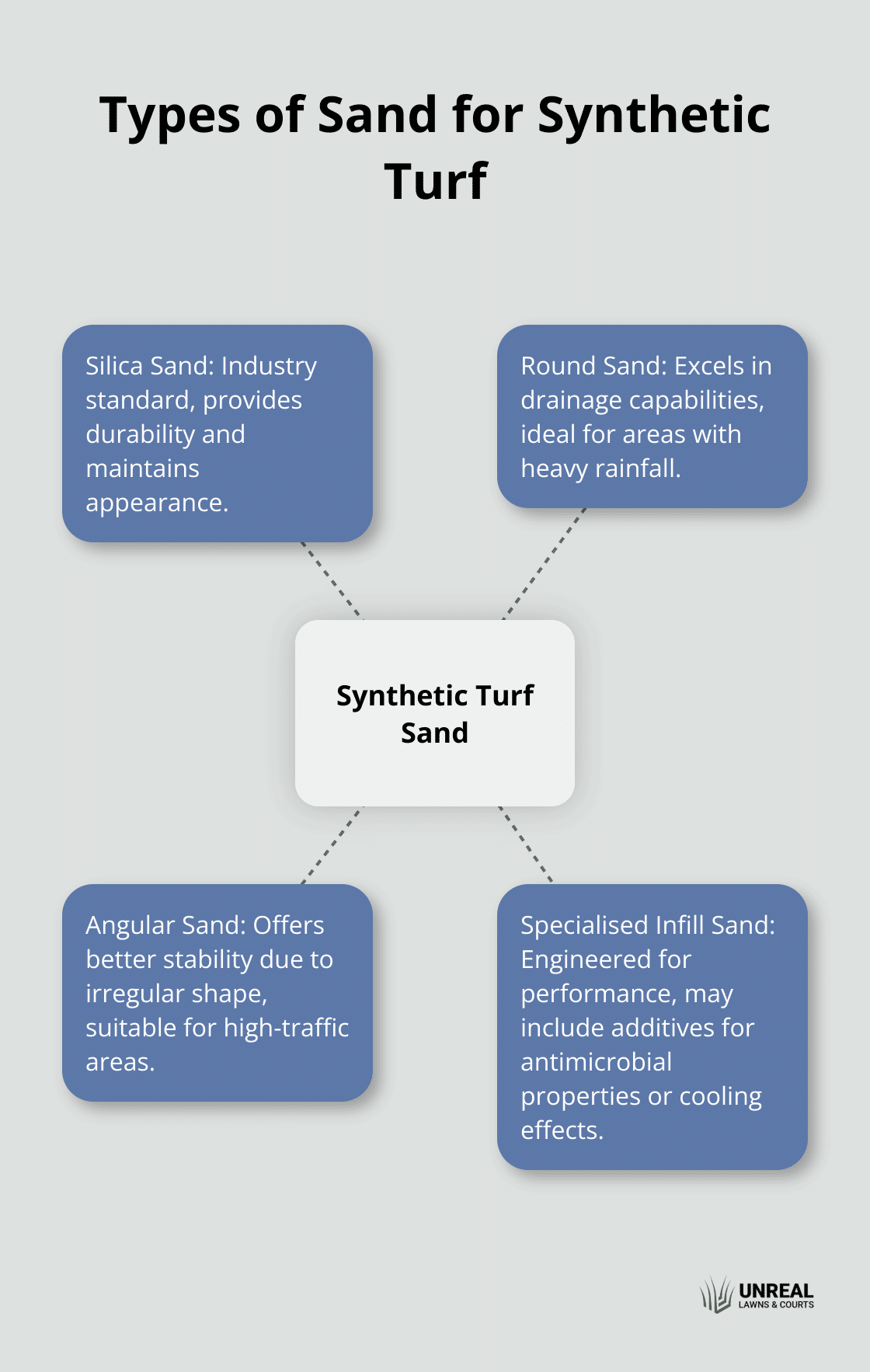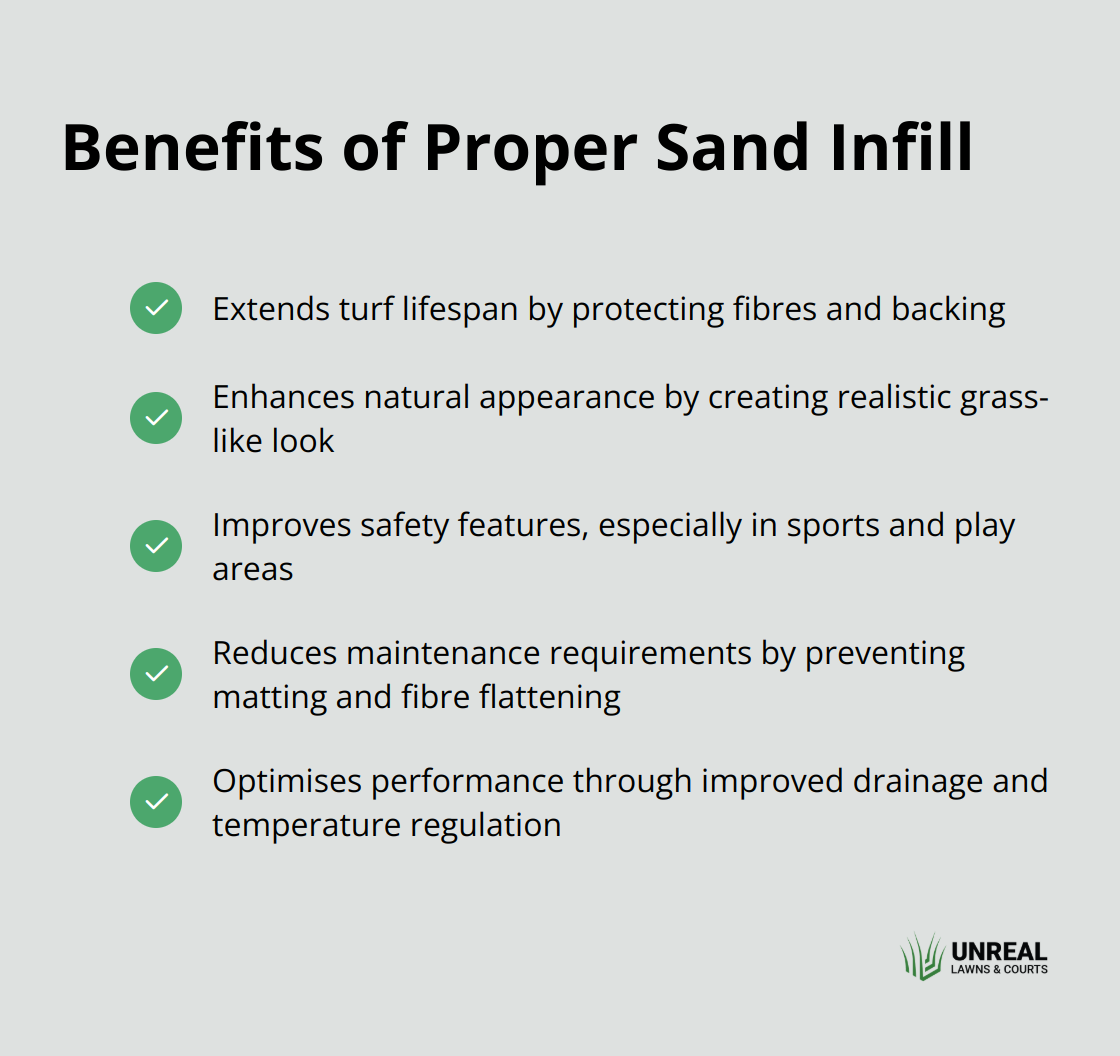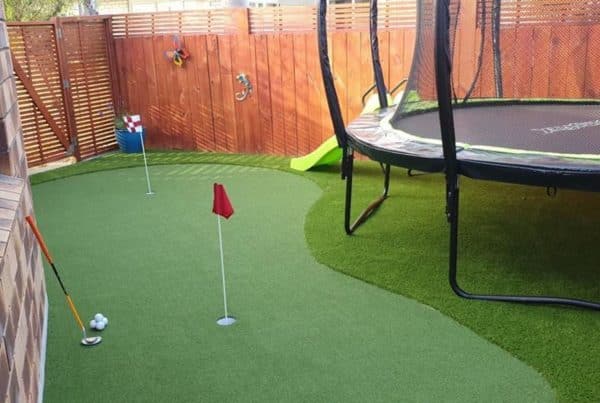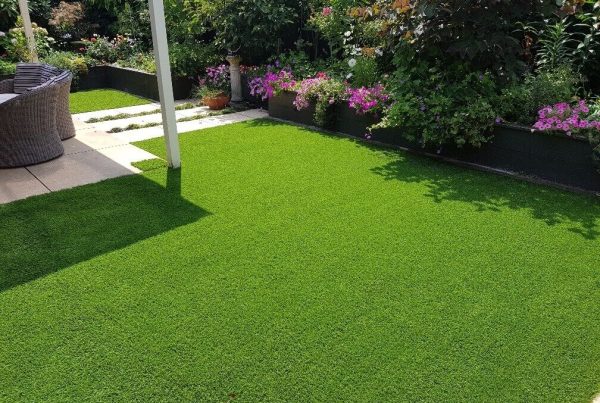At Unreal Lawns & Courts, we know that synthetic turf sand plays a vital role in artificial grass installation.
This often-overlooked component is key to creating a durable, realistic, and low-maintenance lawn.
In this post, we’ll explore the importance of sand in synthetic turf systems and how it contributes to the overall quality of your artificial grass.
Why Sand Matters in Synthetic Turf
Sand transforms synthetic turf installation from a simple surface replacement to a high-performance outdoor solution. This essential component impacts the performance, longevity, and overall quality of artificial grass in several key ways.
Stability and Support
Sand infill anchors artificial grass fibres firmly in place. A typical installation requires 10-18 kg of sand per square metre, which provides substantial weight to keep the turf stable (especially in windy conditions). The sand settles around the base of each blade, offering vertical support. This support maintains the upright position of grass fibres, preventing unnatural flattening or bending.
Shape Retention and Durability
Sand in synthetic turf preserves its shape over time. Sand particles position themselves between artificial grass blades, keeping them separated and upright. This separation prevents matting, a common issue in poorly installed or maintained artificial lawns. The reduction of matting extends the turf’s lifespan significantly, ensuring a fresh and natural appearance for years.
Enhanced Drainage
Proper drainage is essential for any outdoor surface, and synthetic turf is no exception. Sand infill creates small channels between turf fibres, allowing water to quickly percolate through the surface. This rapid drainage prevents water pooling, which can lead to algae growth or an unstable playing surface. A well-installed synthetic turf system with appropriate sand infill allows for immediate use after heavy rainfall, showcasing its excellent drainage capabilities.
Temperature Regulation
Sand infill helps regulate the temperature of synthetic turf. Its heat capacity assists in keeping the turf cooler during peak summer temperatures. Water sprinkling on sand-infused turf can help to reduce the temperature of the turf significantly during peak midday summer temperatures, making it more comfortable for users during hot weather.
Safety Enhancement
The use of sand in synthetic turf installations improves safety for various applications. It provides a more stable surface for sports and play areas, reducing the risk of slips and falls. Additionally, only artificial grass with sand infill undergoes testing for fire resistance, making it safer for both outdoor and indoor applications.
The importance of sand in synthetic turf installation cannot be overstated. It’s not merely an optional extra but a fundamental component that ensures functionality, durability, and aesthetic appeal. The next section will explore the different types of sand used in artificial grass installations and their specific benefits.
Which Sand Works Best for Synthetic Turf
Silica Sand: The Industry Standard
Silica sand stands as the most popular choice for synthetic turf installations. It provides durability and helps maintain the appearance of the artificial grass. This type of sand is suitable for lawns and residential applications.
Specialised Infill Sand: Engineered for Performance
Some manufacturers produce specially treated infill sand designed specifically for artificial turf applications. These engineered sands often combine the benefits of both round and angular particles. They may include additives that enhance antimicrobial properties, improve drainage further, or provide additional cooling effects (features that can significantly extend the lifespan of the turf).
The selection of the right sand type for your artificial grass installation plays a critical role in achieving optimal results. Factors such as local climate, intended use, and specific turf requirements should influence your decision. Professional installers can provide expert guidance on the best sand choice for your specific synthetic turf project, ensuring a beautiful and durable result.

The next section will explore the numerous benefits of using the right sand for your artificial lawn.
Why Sand Matters for Your Artificial Lawn
Extending Turf Lifespan
High-quality sand infill serves as a protective shield for artificial grass fibres. It guards the turf backing against direct UV exposure, which can lead to early deterioration. A study conducted at Penn State University suggests that synthetic turf with nylon fibres is more abrasive than synthetic turf with other fibre types. This information can be valuable when considering the type of artificial grass to install and the appropriate infill to use.
Enhancing Natural Appearance
The right sand infill contributes significantly to the realistic look and feel of artificial grass. It adds weight to the fibres, creating a more natural, grass-like appearance. Fine-grain silica sand, for instance, settles between the blades, providing slight separation that mimics natural grass growth patterns. This subtle detail can make a substantial difference in the overall aesthetic of your lawn.
Improving Safety Features
Sand infill plays a key role in enhancing the safety of artificial turf, particularly in sports and play areas. It provides additional cushioning, which reduces the risk of injuries from falls.
Reducing Maintenance Requirements
The use of appropriate sand in your artificial lawn installation can dramatically cut down maintenance needs. Quality sand infill prevents matting and fibre flattening, keeping your turf looking fresh with minimal effort. It also helps distribute weight evenly across the surface, reducing wear patterns in high-traffic areas. This translates to less time spent on upkeep and more time enjoying your beautiful, low-maintenance lawn.
Optimising Performance
The right sand infill optimises the performance of your artificial turf. It improves drainage capabilities (allowing water to percolate quickly through the surface), regulates temperature (keeping the turf cooler during hot weather), and enhances the overall durability of the installation. These factors combine to create a high-performance outdoor solution that stands up to heavy use and varying weather conditions.

Final Thoughts
Synthetic turf sand plays a vital role in artificial grass installation and performance. It provides stability, enhances durability, improves drainage, and contributes to the overall aesthetics of your lawn. The right type of sand can extend the lifespan of your turf, reduce maintenance needs, and create a safer environment for various activities.
Different types of sand offer unique benefits, from superior drainage to enhanced stability. The selection process should consider factors such as local climate, intended use, and specific turf requirements to achieve optimal results. Professional installation maximises the benefits of sand infill and ensures a high-quality outcome.
Unreal Lawns offers premium artificial grass solutions for residential and commercial spaces across New Zealand. Our team combines knowledge of synthetic turf sand with top-quality materials to create beautiful, low-maintenance outdoor spaces (that withstand heavy use and harsh conditions). You can invest in a durable, aesthetically pleasing, and hassle-free lawn that will serve you well for years to come.





